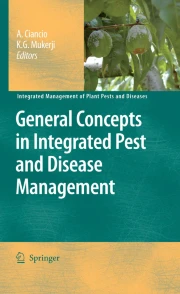
This is a preview of subscription content, log in via an institution to check access.
eBook EUR 160.49
Price includes VAT (France)Softcover Book EUR 210.99
Price includes VAT (France)Hardcover Book EUR 210.99
Price includes VAT (France)Tax calculation will be finalised at checkout
The proposal for this series originated during a short term visit of Professor Mukerji to the Plant Protection Institute of CNR at Bari, Italy, in November 2005. Both editors agreed on the need to produce a volume focusing on recent advances and achievements which changed the practice of crop protection in the last decade. The opera rapidly evolved towards a long term editorial endeavour, yielding a mul- disciplinary series of five volumes. In view of environmental and health concerns, a determined effort is currently made in almost any agroecosystem in the world, to reduce and rationalize the use of chemicals (pesticides, fungicides, nematocides etc. ) and to manage pests/pathogens more effectively. This consciousness is not only related to the need of nourishing a still growing world population, but also derives from the impact of side effects of farming, like soil, water and environmental contamination, calling for a responsible conservation of renewable resources. There are increasing expectations at the producers and consumers levels, concerning low inputs agriculture and residues-free food. Disciplines like IPM/IDM (integrated pest management / integrated disease management) are now central to the science and technology of crop protection. In the classical version of IPM/IDM, a pesticide/fungicide is applied only when the pathogen population reaches a level that would lead to economic losses in the crop. In other words, classical IPM/IDM concentrates on reducing the numbers of noxious organisms through the application of agrochemicals.
From the reviews:
"IPM/IDM (integrated pest management/integrated disease management) began in the 1960s as a movement to reduce the amount of pesticides in the environment and to develop sound, biologically based, integrated management strategies to control plant pests and diseases. … Selected topics cover the relationships of IPM/IDM with advances in use of global positioning systems, the dynamics of global warming, application of information technology, deployment of gene management strategies, use of genetically modified hosts, and introduction of novel biological controls. Summing Up: Recommended. Upper-level undergraduates and above." (R. Frederiksen, CHOICE, Vol. 45 (6), 2008)
Dr Aurelio Ciancio is a research scientist at the Istituto per la Protezione delle Piante (former "Istituto di Nematologia Agraria"), Consiglio Nazionale delle Ricerche, Bari, Italy, since July 1984, and leader of a research line within the Agro-food CNR Committee and Department. He was President of ONTA (Organization of Nematologists of Tropical America) for the years 2005-2006, and is Secretary of the Società Italiana di Nematologia, and a member of several international scientific societies. Currently he is Vice President of the IFNC, International Federation of Nematological Societies, in charge of the Fifth International Congress of Nematology (Brisbane, Australia, July 2008).
Dr Ciancio’s research activities concern fundamental and applied aspects of biological control of plant parasitic nematodes, parasitology of invertebrates, soil microbiology and molecular biology, microbial modeling and detection of soil microorganisms. He has authored more than 100 national and international publications, he coordinated one EU-INCO project and participated in three other EU funded projects.
He peer reviewed manuscripts for several scientific journals, including Biocontrol Science and Technology, the Canadian Journal of Zoology and the European Journal of Protistology. He also reviewed projects for NERC (Natural Environment Research Council, UK) and USDA. His research is actually funded through the EU, national and regional projects, aiming at the development of industrial products (natural and microbial nematocides) based on soil microorganisms.
Professor K.G. Mukerji published 20 international books/volumes on various aspects of applied mycology, plant pathology and microbial ecology during 1980- 2005 with publishing houses such as Kluwer Academic/Plenum Publishers, Marcel and Dekker, CRC Press Inc. and Springer Verlag. In addition 20 other books/volumes were published by reputed Indianpublishers.
Professor Mukerji has published over 600 research papers and he is on the editorial board of several national and international journals dealing with botany, mycology, plant pathology and biotechnology. More than 60 students received a PhD degree under his supervision. He is a member of several societies and associations concerning mycology, plant pathology and microbial ecology. Professor Mukerji is a distinguished mycologist and microbial ecologist and well reputed for his research contributions all over the world and a popular editor/writer for applied mycology, microbial ecology and plant pathology books. His books are used as reference books in the field all over the world.